 Edward Angus "Ted" Burton
Edward Angus "Ted" Burton
In late 2020, retired Superintendent George Rose was immersed in a project to write an article about the tremendous contribution Ted Burton had made in conducting research and writing about the history of the Bermuda Police while serving here between 1951 and 1967. Within four years of his arrival Ted had written the first ever comprehensive history of the Police Force, “The Policing of Bermuda from the earliest times” published in the Bermuda Historical Quarterly magazine in 1955. CLICK HERE to view our article on Ted Burton in our Hall of Fame.
Ted went on to write at least two more excellent history-related articles, the first of which was about the inauguration of the Fingerprint Department in 1924 which he most likely wrote after he was transferred to the Criminal Records Office (C.R.O.) in October 1958. For anyone not familiar with the Criminal Records Office it also includes the Fingerprint Section.
Ted’s article provides fascinating insights into the inauguration of the Fingerprint Department.
Ted commented on occasions throughout the body of this article:
(Editors note - We now know that the first ever police officer designated as a detective was Charles Edward Simons who later became known as "D.O." for Detective Officer, and you will read below that he was one of the two police officers sent to New York in November 1924 to study the new science of fingerprinting. CLICK HERE to read his lifestory in our Hall of Fame.)
Whatever duties these officers carried out at the time, it may be said without any doubt that the C.I.D. did not get properly underway until the introduction of the Fingerprint Department in 1924.
No Criminal Investigation Department can be complete without a Fingerprint Section. It is, therefore, of great interest to record exactly how this section was introduced into the Bermuda Police Force.
Such a project cannot have been an easy matter in a Force so small at that time and one which had so little money available. The sequence of events leading to the introduction of the section, is, therefore, quite remarkable.
“Dear Sempill,
Has it ever been suggested here that the Bertillon system should be introduced. I believe it would be of great assistance to you. It is a great deterrent to crime and would enable you often to fix on the perpetrators of such crimes as have been lately taking place.
It is very easily learned. Any intelligent man can learn it in a few days. That is to say, the system of fingerprints and the indexing of them. The searching for fingerprints after a crime has been committed and the photographing of them is a matter which requires training and instruction but an intelligent man could learn in a few months.
You probably know all about it and its value and will be able to say what objections there are to it. I know in the Sudan the inhabitants were frightened of it and I believe they would be here.”
To my knowledge this was the first indication that fingerprints might be introduced in Bermuda although, of course, it may well have been talked about for some time before this.
It should be noted that the Governor refers to the ‘Bertillon System’ which concerned measurements of certain bone structures of the body. It is most probable that he actually meant the ‘Henry System’.
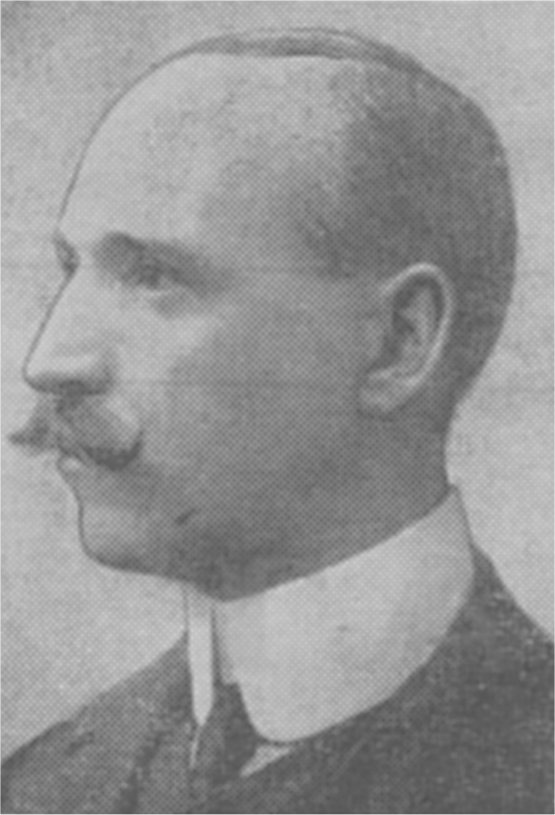 Chief of Police John H. Sempill
Chief of Police John H. Sempill
SEMPILL’S REPLY TO THE GOVERNOR
The Chief of Police replied rather lengthily to this letter and it appears that the possibility of introducing finger prints had been on his mind for some time and it would not have been long before he, himself, would have brought the matter up.
The following paragraphs of his letter are of interest and serve to show that then as now the police had much the same problems. He mentions that he attended a finger print course at Scotland Yard 12 years ago (circa 1912).
“I greatly fear that we are no longer going to enjoy immunity from the foreign criminal that we have hitherto. Our inquiries in connection with the recent burglaries revealed the fact that there are in the Colony at the present time a number of alien men, not visitors, who are a mystery to us, who do not work, who have plenty of money to spend, and who are continually being seen under suspicious circumstances. Of course this is incidental to the expansion of every country, and as Bermuda develops, so there will be more and more of the undesirable elements.
It looks as if a light railway for Bermuda is going to be sanctioned. This probably would be a very good thing for Bermuda but we should bear in mind that to construct the railway will mean the introduction in the Colony of large gangs of navies, a class of men difficult to control and amongst whom there are sure to be a number of criminals.
I mention this as an additional reason why the Force should be made as up to date and efficient in its methods as possible.
I have had these matters before me for some considerable time and the reason I did not bring them forward was because I considered it hopeless to ask the House of Assembly to do anything more towards placing the Force on a more efficient footing so soon after the re-organization of the Force. But I think now the time is most opportune for any proposals, having for their object the improvement of the efficiency of the Police Force, to be put forward.
The public, in view of all the burglaries which have been taking place during the last six weeks and the somewhat dramatic arrest of the burglar in the act last Saturday, are in a mood susceptible of realizing how dependent they are for their comfort, well-being, and safety upon an efficient policed force.
It was the same four years ago. For five years before the Governor, Colonial Secretary and myself had been striving to convince them of the necessity for providing a proper police force but it was only when they became actually afraid for their safety that they paid any heed to our representations.”
“His Excellency having suggested to me the advisability of introducing into Bermuda the Fingerprint method of identifying and detecting criminals, I have the honour to report that steps should be taken to introduce it with as little delay as possible.
I received my last instruction in Fingerprints at Scotland Yard 12 years ago but it has been altered and improved since then and I would require a fresh course of instructions before I could adapt it here.”
Mr. Sempill went on to say that the Police Department in New York had offered to train men from other police forces and suggested that three officers, including himself, should be sent on a course.
In the meantime the Colonial Secretary enquired from Mr. Sempill regarding the expenses involved. It was estimated that apparatus and equipment would cost £300, passages for the three officers £150 and cost of maintaining the system would be £50 per annum.
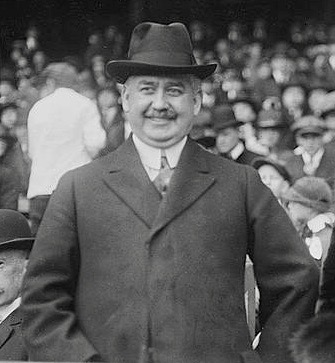
It is rare that anything can be introduced into a police force at merely the cost of buying the material or training of officers. Inevitably the costs snowball, and so it was in this instance, for the police had nowhere to house the Fingerprint Section. It was agreed therefore that a room should be built over the cells with a communicating bridge to the first floor landing of the police station at a cost of £225. This room was destined to be used for the following 32 years.
Fingerprint Bureau
Photographic
“The Governor has the honour to inform the Honourable House of Assembly that the question of the adoption in this Colony of the Fingerprint System for Identification and detection of criminals has recently been under consideration.
In view of the growth and expansion of the Colony, it is very desirable in the Governor’s opinion tha the most scientific and up-to-date methods dealing with this question should be provided for. He considers that in view of the comparatively small expense entailed that it is in the best interest of the community that such a system of dealing with crime should be instituted.”
It went on to relate the cost etc. of the scheme.
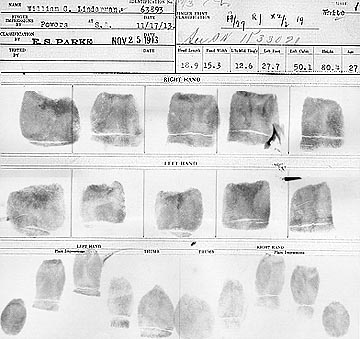
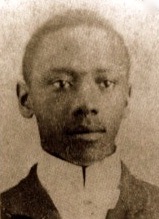 P.C. Charles Edward Simons
P.C. Charles Edward Simons
Meanwhile, the Chief of Police reported to the Colonial Secretary on his trip as follows –
“On the date of my arrival I attended the first of a series of lectures given to Fingerprint Experts and representatives of the Police Departments throughout the United States, Canada, Mexico, Cuba, Puerto Rico and the Central American countries. This series of lectures last a week. The subjects of the lectures are contained in the attached curriculum.
On the 6th October, I commenced a course of instruction in the application and classification of fingerprints. After three weeks study thereof, I qualified as a Fingerprint Expert.
I cannot speak too highly of the manner in which all the facilities of the Criminal Identification Bureau were placed at my disposal not of the courtesies and many kindnesses I received at the hands of the officers of the Department.
Whilst in New York I purchased all the necessary fingerprinting apparatus including an identioscope, the most modern device for taking photographs.
When talking the matter over with Police Commissioner Enright the day before leaving New York he undertook, if we made formal application for his services, to send Captain Golden, the Chief of the Criminal Identification Bureau, to Bermuda for about a fortnight to supervise the inauguration of our Bureau in order that there will be no mistake in starting it properly.
The Commissioner stated that there would be no charge for the services of this officer and I on my part undertook to put Captain Golden up as my guest during his stay in Bermuda. When inquiring tentatively about passenger rates for this officer from Captain Barlow of the New York office of the Furness-Bermuda Line, Captain Barlow said he would place the matter before Mr. Blackiston, the New York manager, and the following day I received word that Mr. Blackiston would be pleased to furnish Captain Golden or other fingerprint experts of the New York Police Department with his Company’s pass and furnish him with necessary accommodation to go to Bermuda for the purpose of installing and starting our Fingerprint Bureau.
I therefore recommend that formal application for the services of Captain Golden be made to Commissioner Enright stating at the same time that arrangements will be made for his transport and entertaining in Bermuda.”
In this day and age one can only question Mr. Sempill’s statement that he “became an expert in three weeks” with an air of disbelief. It may be, however, that such was the case.
“Dear Chief,
We docked at Pier 95 at 11 a.m. Monday 10th inst. after a rough day on Sunday which put the majority of the passengers, Simons included, “hors de combat” so to speak.
After lunch at the hotel I went to Headquarters and paid my respects to Inspector McKinney and gave him your message. I also saw Deputy Commissioners Simons and Fouror.
As soon as Detective Officer Simons arrived I went to the Identification Bureau and reported to Capt. Golden. Both Simons and myself put in a hard afternoon’s work
Simons is making good progress considering he did not understand fingerprint [s] before. Det. Sgt. Hammersley is satisfied with the way he is shaping.
The work is most interesting and I am now classifying my share of the prints that came in daily and searching for the wanted criminals in the files. I found two yesterday in less than five minutes, and one of them was in the largest classification in the Bureau. The classifying of prints was very easy after the theoretical knowledge I acquired in Bermuda. In searching the files I found two which referred to criminals we have dealt with in Bermuda for bootlegging and unlawful wounding.
Capt. Golden rang up the contractor with reference to the equipment ordered by you and they have promised to expedite delivery. The Capt. is taking me to the firm on Tuesday to see a demonstration of the Identiscope and to the shipping office to arrange his ticket to Bermuda.
As far as Capt. Golden knows at present he will leave on the 13th December, 1924.
I took part in the Parade up Fifth Ave. on Tuesday 11th, 1924, and heard Mayor Hylaw speak at Central Park. At the conclusion of the ceremony I had an opportunity of speaking to His Worship
The weather is very cold and dry, and at the moment there is every indication of snow falling soon.
Had a chance to see the terrible fire in Jersey City which burned two blocks with damage estimated at £1,000,000.Thirty fire engines went from New York and while on my way to N.J. after lunch four of them crossed town to take up the positions vacated by engines sent to Jersey City. It is truly wonderful to note the efficiency of the Fire Department of the City, and it affords food for reflection by our City Fathers in Hamilton that they are not up to date in this respect.
Mr. Priest came to me today and stated he was out of a job and I advised him to go to Bermuda at once. This man applied for a position on the Bermuda Police Force last year but owing to the fact of his obtaining work in New York he did not come on to Bermuda at that time. He is a good man with lots of Police experience and will be an acquisition to our Force. The New York Police Dept. would have taken him on their strength had he been naturalized.
Sergeant Burton continues:
To digress a little – the Mr. Priest mentioned above did come to Bermuda and did join the Force. It would appear however, that his life was not a happy one for in 1928 he was sent to prison for three years for a serious assault on his wife.
[This Mr. Priest is believed to be Ernest Edward Priest who served between 22.09.1927- 02.07.1928]
During November the various pieces of equipment required for setting up the Department arrived. All of it was purchased in the United States. Even in 1924 fingerprinting was still in the development stage, particularly concerning the use of powder, inks and rollers. Quite a lot of trouble was experienced in the early stages to find a roller with a rubber suitable for Bermuda’s climate.
I classified 32 prints on Thursday and Simons is beginning to understand this part of the work.
I trust that the work in the Force is normal and the criminals are trying to behave themselves. One thing is certain, and that is, we will be more successful in getting them than heretofore."
In reading some of the correspondence from the suppliers it can be clearly seen that they were jealously guarding the copyright of the methods developed by them, particularly in the use of powders. Bermuda's consignment of powders, for instance, was accompanied by type written instructions on how to use them. There was the added warning, however, that such instructions were for the use of the Bermuda Police Force only!
Capt. Golden was introduced by Mr. Sempill who related the events leading to Capt. Golden’s visit. He was referred to as ”A Police Officer of international repute -— ranking with Jorgensen of Norway, Collins of Scotland Yard and other police officials equally celebrated".
Capt. Golden said that “his coming to Bermuda on his present mission was a sort of compliment to the Metropolitan Police organisation of London and that the world was indebted for the fingerprint system to the officers of Scotland Yard, by whom it was inaugurated in 1901. In 1905, officers of the New York Police Department went to Scotland Yard brought back the fingerprint system.
Since then other countries had adopted it, and, in introducing it here the Government of Bermuda was only following the example of other British Colonies and when the system had been adopted this Colony would have made a decided step in advance .”
The Royal Gazette reported as follows:
“Captain Golden had returned from a European tour and was fully conversant with the various systems employed in the great cities, and he was sure that the audience would learn much that would help them to understand the necessity for the inauguration of the Fingerprint System here, and which might also remove any lingering doubt in their minds on the efficiency of the science.
“Captain Golden, in a few well-chosen words, expressed his appreciation of the reception accorded him on his arrival in Bermuda and which had culminated in such splendid and representative meeting.
“Coming to the subject he briefly outlined the growth of the system and showed pictures (operated splendidly by Mr. St. George Butterfield with his excellent stereoscope) tracing the development from photos, the Bertillon system of bone measurements, up to the absolute, fool-proof, scientific Fingerprint System.
“Magnified impressions of the fingers were shown and the various classifications enumerated. No two fingerprints were alike, and by a careful compiled system, records could be taken and transmitted all over the world and identification made without the possibility of mistake. This was made clear by a mathematical process that proves 900 characteristics on each person's finger tips, reveals an endless number of combinations, and formulates a principle that makes search through records a matter of minutes.
“After showing a number of imprints that had led to the capture of criminals when every other clue failed, the lecturer took two impressions in order to demonstrate his work,
“Much amusement was caused when he singled out the Hon. S. S. Spurling to step forward and touch a piece of blank paper. Mr. Spurling, with a courage that bespeaks innocence immediately went to a table and in passing touched the paper. In a few moments, by the aid of a specially prepared powder, Captain Golden had produced a vivid and accurate impression of the hand that rules Bermuda.
“(It was noticeable that Mr. Spurling took away the impression at the close of the meeting. He always was long sighted.)
“Captain Pitt was the next victim. He was asked to carry a bottle from one table to another (a matter of two seconds to this man of high stature).
“But it was enough to convict him if ever his fingerprint is wanted."
At the conclusion of the lecture and demonstrations His Excellency proposed a vote of thanks and said he had “seen the fingerprint system used in the East, where it is everywhere recognised. In the Sudan the native uses his thumb print for a receipt of money. The natives of Africa also know about it. During the war, every Chinese labourer employed was fingerprinted and when these were scattered they were easily rounded up by means of the identification system."
Captain Golden stayed two weeks and in this time was able to get the Finger Print Department on an operational footing, the system, however, did not make a spectacular start. The officers were still learning the subject and in addition they had experienced considerable trouble from much of the equipment purchased from the United States. Some of the drawers sent would not fit into the cabinets. Parts of the woodwork was warped and split in several places and the doors of the Rogues’ Gallery sprung and would not close properly. No doubt much of this was due to Bermuda's climate.
As much of this same equipment was in use until quite recently, the Force has not been over extravagant in this respect!
As mentioned previously, one of the difficulties experienced at the beginning was that the ink rollers were too soft and soon rotted away. The firm supplying the rollers was informed and they replied:——
"I thank you for your kind letter of June 29 and am glad to learn that you were able to get a shield made locally, without delay, and have cancelled your Order for a special shield, as requested.
In reference to ink rollers, there is no difficulty about this, while we know that the rollers furnished you are too soft for your climate, and we are very much obliged to you for giving us this information. We will make up a few ‘tropical’ rollers and send you a couple of these, free of charge, very shortly.
l note your suggesting Gutta percha and think perhaps you mean tough rubber, as gutta percha loses its elasticity in a short time and has never, as far as l know, been used in printer's or ink rollers of any kind. Rubber can be used for finger print rollers and while I had charge of the Central Finger Print Office in Singapore from 1902 to 1906 we used a pure red rubber roller sent to us from London. It became too sticky after a little while, and had to be changed quite often. In this country, regular composition rollers made from glue and molasses, or glue and glycerine, with some other ingredients, are manufactured to suit any climate and are being furnished to printers in the South American countries and, I think, in the Orient, as well.
The proper way about ink rollers is to change them with the season. And, in case you have a rainy season and a dry season, the chances are you will need two kinds of tropical rollers to obtain the best results. We shall be very glad to co-operate with you in this matter and l will write you further when we send the new rollers."
It is interesting to speculate what this firm would have to say on this same subject today!
No doubt there were many more troubles than l have been able to discover, but eventually there was also success. The day the first prisoner in Bermuda was convicted on finger-print evidence alone must have been a happy day for all those concerned in the introduction of the Finger Print Department. This momentous occasion did not occur until nearly two years after the system was introduced.
“I have the Honour to report for the information of His Excellency that at the Michaelmas Term of the Criminal Sessions held last month, the third conviction by means of finger print identification was obtained since the inauguration of the system in Bermuda in December, 1924.
Unlike the two former cases, in this case the police relied entirely on the identification of the finger impression left at the locus of the crime for a conviction, and it is satisfactory and re-assuring to know that the prisoner, shortly after receiving sentence of two years’ imprisonment, confessed his guilt.
In connection with these convictions I have pleasure in directing the attention of His Excellency to the good work displayed by Inspector Williams and Detective Officer Simons through whose instrumentality the convictions were obtained and in connection with the last conviction I consider that the Inspector is deserving of special commendation not only for the able manner in which he prepared the evidence for presentation but for the lucid and convincing way in which he gave his evidence before the Court and Jury.
Sergeant Burton further informs:
It has not been possible to locate the file on the above case. On reflection, perhaps this is just as well because it may be that some of the glamour would rub off were we able to publish copies of the fingerprints submitted in evidence. From photographs and comparison of fingerprints seen of this period there is not much doubt that such standards of work would not be accepted in courts today.
There were still doubts, even in the minds of most eminent legal men, that the evidence of fingerprints was not conclusive for identifying a person so perhaps it would not be amiss to reiterate once again what the chances are of finding two fingerprints alike.
Many mathematical theories have been expounded on this subject but as this article deals with fingerprints prior to 1924, it is of more interest to quote the writings of that period.
“Sir Francis Galton figured that chances were sixty-four billion to one against there being two fingerprints alike. But a French student of fingerprints, Mr. H. V. Balthazard, recently addressed a report to the French Academy of Sciences, and in that report computed the chances to be only a fraction of Sir Francis Galton’s figures.
Balthazard wrote that if any fingerprint be divided into 100 squares, each square will contain some distinctive mark, rarely two marks, and only in most exceptional cases three or none. (sic) By distinctive marks he means bifurcations, ridges or terminations. Fingerprints differ from each other either in the arrangement of the ridges in the different squares, or in the character ridges in a particular square.
The total number of combinations possible is the hundred power which is
1,000,000,000,000,000,000,000,000,000,000,000,000,000,000,000,000,000,000,000,
000. This means that there are just so many combinations, and the chances are the above number to one that any combination will not happen more than once.
In order to compare this chance with human chances generally, it is necessary to consider the population of the world which is, in round figures, 1,500,000,000. As there are about three generations per century, the total number of persons per century would be fifty thousand million.
To have enough people to realize all the possible combinations of fingerprints would require a period of 2,000,000,000,000,000,000,000,000,000,000,000,000,000,000,000, 000 years, and the chances of there being any two fingerprints alike would be once in that many years.”
Anyone who has knowledge of the Fingerprint Department today will realize that great strides have been taken since the system was inaugurated and that we are continually keeping abreast of modern methods where their introduction is beneficial to the Force. The officers are highly trained in accordance with the standards set at Scotland Yard. Is it too much hope for that Bermuda will one day produce its own Golden, Collins, Battley or Cherill?
In conclusion I should like to mention that the Battley system of classification was introduced to the Force in 1930 – probably shortly after publication of his book. Evidently there was some correspondence between Chief Inspector Battley and Mr. Williams on the subject and one letter from the Chief Inspector has survived. I end this article by quoting the letter mainly because it shows that a large organization like Scotland Yard with all its ramifications has time to pause a while and look after the interests of such a small force as Bermuda.
I regret that one of the glasses is defective, but have been in communication with Messrs. Sharland, who express their willingness to remedy the defect should you care to return the glass.
It gives me great pleasure to learn the new system is likely to assist you and trust that the results of its installation will be as satisfactory as those obtained in the Bureau.”
Yours sincerely,
EDITORS NOTE - As mentioned earlier, the young constable who went to New York to obtain instruction in the new science of fingerprinting along with Inspector W.N.T. Williams was Charles Edward Simons had been appointed as Bermuda’s first ever detective in 1919 . Detective Officer Simons, or “D.O.” as he was fondly known, went on to gain a reputation as a legendary detective becoming head of C.I.D. for many years until his retirement in 1935. CLICK HERE to read his lifestory in our “Hall of Fame” column.
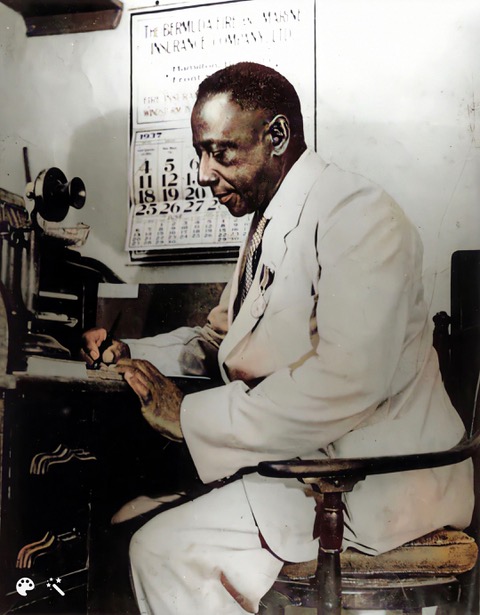 Charles Edward "D.O" Simons was appointed as
Charles Edward "D.O" Simons was appointed as